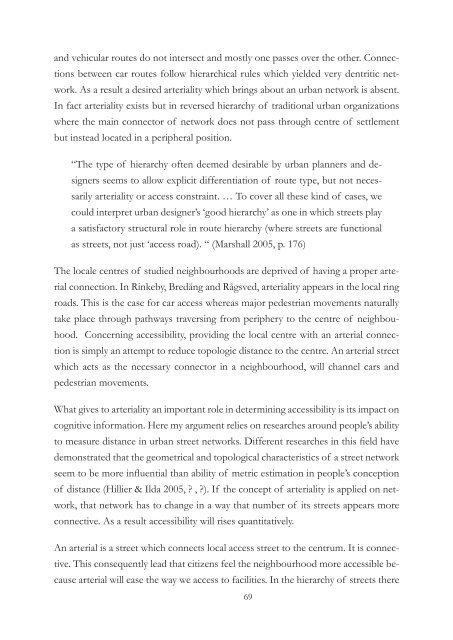Accessibility and Street Layout Exploring spatial equity in
Accessibility and Street Layout Exploring spatial equity in
Accessibility and Street Layout Exploring spatial equity in
You also want an ePaper? Increase the reach of your titles
YUMPU automatically turns print PDFs into web optimized ePapers that Google loves.
<strong>and</strong> vehicular routes do not <strong>in</strong>tersect <strong>and</strong> mostly one passes over the other. Connections<br />
between car routes follow hierarchical rules which yielded very dentritic network.<br />
As a result a desired arteriality which br<strong>in</strong>gs about an urban network is absent.<br />
In fact arteriality exists but <strong>in</strong> reversed hierarchy of traditional urban organizations<br />
where the ma<strong>in</strong> connector of network does not pass through centre of settlement<br />
but <strong>in</strong>stead located <strong>in</strong> a peripheral position.<br />
“The type of hierarchy often deemed desirable by urban planners <strong>and</strong> designers<br />
seems to allow explicit differentiation of route type, but not necessarily<br />
arteriality or access constra<strong>in</strong>t. … To cover all these k<strong>in</strong>d of cases, we<br />
could <strong>in</strong>terpret urban designer’s ‘good hierarchy’ as one <strong>in</strong> which streets play<br />
a satisfactory structural role <strong>in</strong> route hierarchy (where streets are functional<br />
as streets, not just ‘access road). “ (Marshall 2005, p. 176)<br />
The locale centres of studied neighbourhoods are deprived of hav<strong>in</strong>g a proper arterial<br />
connection. In R<strong>in</strong>keby, Bredäng <strong>and</strong> Rågsved, arteriality appears <strong>in</strong> the local r<strong>in</strong>g<br />
roads. This is the case for car access whereas major pedestrian movements naturally<br />
take place through pathways travers<strong>in</strong>g from periphery to the centre of neighbouhood.<br />
Concern<strong>in</strong>g accessibility, provid<strong>in</strong>g the local centre with an arterial connection<br />
is simply an attempt to reduce topologic distance to the centre. An arterial street<br />
which acts as the necessary connector <strong>in</strong> a neighbourhood, will channel cars <strong>and</strong><br />
pedestrian movements.<br />
What gives to arteriality an important role <strong>in</strong> determ<strong>in</strong><strong>in</strong>g accessibility is its impact on<br />
cognitive <strong>in</strong>formation. Here my argument relies on researches around people’s ability<br />
to measure distance <strong>in</strong> urban street networks. Different researches <strong>in</strong> this field have<br />
demonstrated that the geometrical <strong>and</strong> topological characteristics of a street network<br />
seem to be more <strong>in</strong>fluential than ability of metric estimation <strong>in</strong> people’s conception<br />
of distance (Hillier & Ilda 2005, ? , ?). If the concept of arteriality is applied on network,<br />
that network has to change <strong>in</strong> a way that number of its streets appears more<br />
connective. As a result accessibility will rises quantitatively.<br />
An arterial is a street which connects local access street to the centrum. It is connective.<br />
This consequently lead that citizens feel the neighbourhood more accessible because<br />
arterial will ease the way we access to facilities. In the hierarchy of streets there<br />
69

















